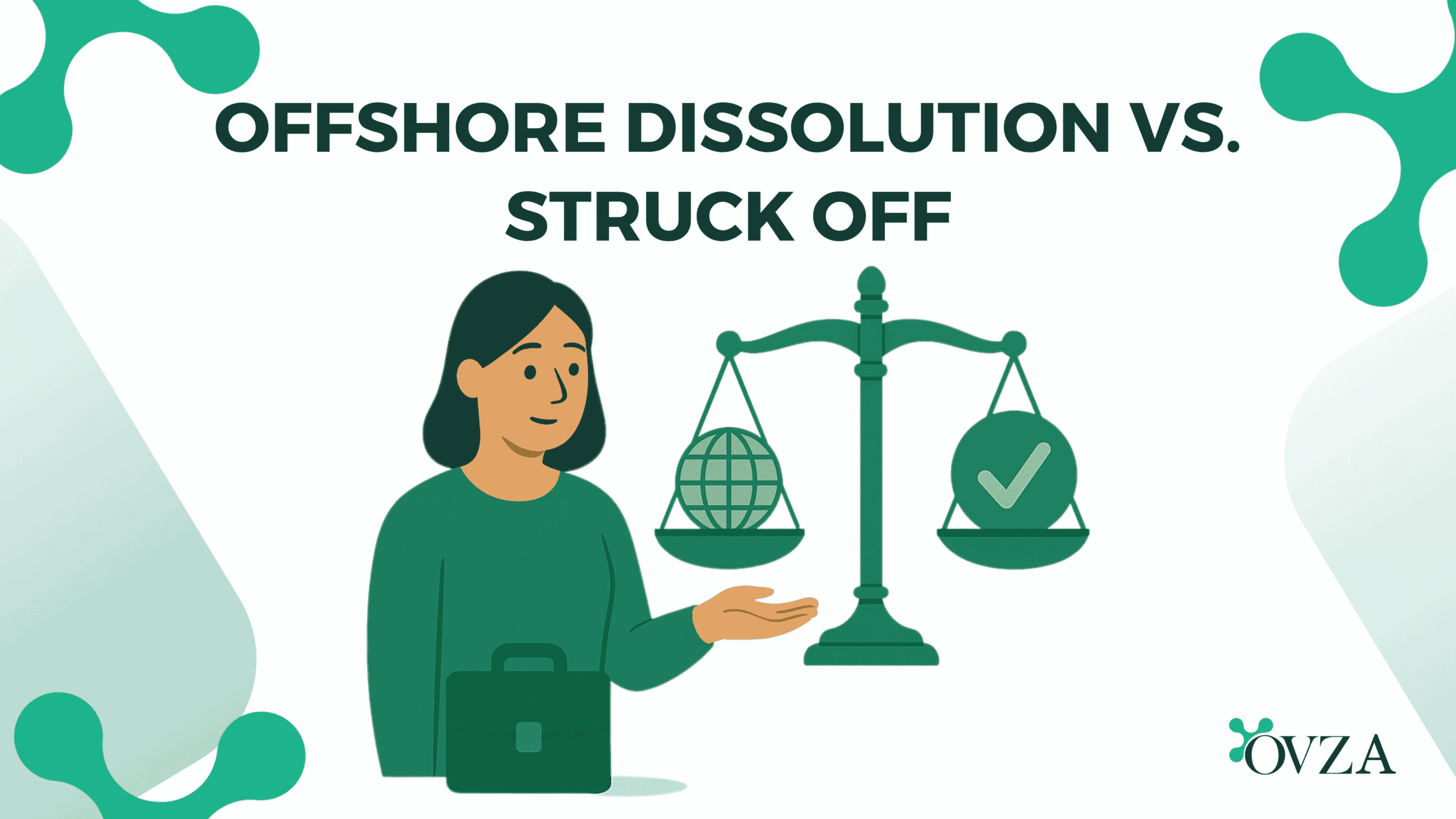The legal, procedural, and regulatory distinctions between offshore company dissolution and being struck off in key jurisdictions. The termination of offshore companies often involves two primary mechanisms: dissolution and striking off. While these processes both lead to the cessation of a company’s existence, they are legally distinct with differing procedural requirements, regulatory implications, and consequences for the company and its stakeholders. Understanding the nuances between offshore dissolution and struck off is critical for legal practitioners, corporate service providers, and business owners operating within jurisdictions such as the British Virgin Islands, the Cayman Islands, Seychelles, and Belize.
Legal Frameworks Governing Offshore Dissolution and Striking Off
Offshore jurisdictions each establish their own statutory regimes that regulate how companies may be dissolved or struck off the register. For instance, the British Virgin Islands’ BVI Business Companies Act, 2004 provides detailed provisions for both voluntary dissolution and striking off. Similarly, the Cayman Islands’ Companies Law outlines processes for winding up companies and administrative removal from the register.
Dissolution typically refers to a formal winding-up process. It can be voluntary or involuntary and involves settling the company’s debts, distributing any remaining assets, and legally terminating the company’s existence. The process generally requires the appointment of a liquidator or insolvency practitioner, particularly in jurisdictions with more complex insolvency laws. In the Cayman Islands, for example, a voluntary dissolution involves submitting a declaration of solvency and notifying creditors before proceeding to liquidation and final dissolution.
In contrast, being “struck off” usually denotes an administrative removal of a company from the register, often due to non-compliance with filing requirements or failure to pay annual fees. This procedure is typically faster and less formal than dissolution but may carry legal risks, especially if the company has outstanding liabilities or contractual obligations. In Seychelles, for example, the Companies Act provides for striking off companies that fail to file annual returns or maintain registered agents, after which the company ceases to exist by operation of law.
The distinction is also important for regulatory compliance and tax considerations. Some jurisdictions require that companies undergoing dissolution file detailed reports and financial statements, ensuring creditor protection and tax clearance. By contrast, companies struck off without proper winding up may remain liable for taxes or claims, potentially exposing directors to legal consequences.
Procedural Differences and Legal Consequences
The procedural distinctions between offshore dissolution and a company being struck off are significant, with direct implications for corporate liabilities, legal standing, and asset recovery. A formally dissolved company undergoes a regulated process that ensures the legal finality of its closure, whereas striking off is often viewed as an administrative action that may be reversible or incomplete under certain conditions.
In most offshore jurisdictions, voluntary dissolution begins with a board resolution followed by a shareholder resolution authorizing the company to wind up. Where the company is solvent, a declaration of solvency may be required under laws such as the Companies Ordinance of Belize. A liquidator is then appointed to oversee the winding up process, which includes notifying creditors, settling liabilities, distributing remaining assets to shareholders, and filing final returns with the corporate registry. Once the liquidator confirms that the winding up is complete, a certificate of dissolution is issued, conclusively terminating the company’s legal existence.
In contrast, a company may be struck off the register without a formal winding up process. This typically occurs when a company fails to comply with statutory obligations such as annual filings, payment of renewal fees, or maintaining a registered agent. In jurisdictions like Seychelles or the British Virgin Islands, regulatory authorities may issue a notice of intent to strike, followed by publication in an official gazette. If the company fails to rectify its compliance breaches within the stipulated period, it will be struck off. However, under the BVI Business Companies Act, a company that has been struck off is not immediately dissolved but enters a suspended state for up to seven years, during which it can be restored to the register.
This distinction matters greatly when considering the legal and financial consequences. A dissolved company cannot be restored and is no longer capable of being party to legal proceedings or owning assets. On the other hand, a company that has been struck off may still retain property or liabilities, and its directors or shareholders may still face enforcement actions. In some jurisdictions, assets of a struck off company may vest in the state after a certain period, under doctrines of bona vacantia.
Furthermore, directors of a struck off company may still have residual fiduciary duties or be subject to civil penalties, particularly if the company was struck off while insolvent or if they allowed the company to trade while knowingly failing to comply with statutory obligations. The Cayman Islands Monetary Authority and similar regulators in other jurisdictions have highlighted the risks associated with abandoning companies without proper closure, including exposure to anti-money laundering and FATCA or CRS enforcement risks.
The distinction between offshore dissolution and struck off also carries reputational implications. A properly dissolved company demonstrates regulatory compliance and good corporate governance, which is especially relevant for companies subject to cross-border information exchange or financial institution scrutiny under international frameworks. Conversely, companies that are struck off for non-compliance may be flagged by regulators, banks, or counterparties, affecting future incorporation or banking options.
Strategic Considerations, Restoration, and Final Closure
Choosing between offshore dissolution and allowing a company to be struck off involves not only procedural differences but also strategic legal considerations that affect asset protection, regulatory exposure, and future operations. For companies operating in multiple jurisdictions, such as those licensed or structured in the Cayman Islands, Seychelles, or Belize, the decision to dissolve or allow a strike-off should be made in alignment with the company’s long-term corporate and compliance objectives.
Dissolution offers finality and legal certainty. Where companies have completed their purpose—such as a private investment vehicle reaching the end of its term or a special purpose entity concluding its transaction—voluntary winding up is the preferred course. This process provides transparency for stakeholders, especially where creditors, investors, or regulatory authorities may later inquire into the company’s closure. In jurisdictions where regulatory oversight is increasingly aligned with international standards, such as those influenced by the OECD’s CRS or FATCA, formal dissolution can help mitigate reputational and compliance risks.
In contrast, companies that are no longer active and have no remaining assets or liabilities may be administratively struck off as a matter of convenience. However, the reversibility of striking off is a key factor. Under the laws of several jurisdictions, such as the BVI Business Companies Act, a struck off company can be restored to the register within a statutory period—commonly up to seven years—if it can demonstrate that it was carrying on business or that restoration is just and equitable. Restoration may be initiated by a shareholder, director, or creditor, and typically requires payment of penalties and evidence of compliance.
This possibility of restoration introduces legal complexity. If a company holds undistributed assets or remains subject to pending claims, those issues do not disappear simply because the company has been struck off. In some cases, restoration may be a tactical tool—for example, to recover misappropriated property or pursue litigation—but it may also expose the company to renewed liabilities, including backdated compliance obligations and sanctions under regulatory frameworks like anti-money laundering laws.
Legal practitioners must also consider whether the company’s records are retained and accessible, as missing documentation can delay or even prevent restoration. Jurisdictions such as Mauritius and the Seychelles have introduced more stringent record-keeping rules and director accountability frameworks, reflecting the global shift toward transparency and enforcement cooperation among regulators.
Strategically, offshore dissolution remains the superior option where clarity and legal closure are priorities. For clients who wish to demonstrate clean exits from cross-border structures, avoid legacy compliance risks, and ensure their corporate footprint aligns with regulatory expectations, dissolution provides a defensible and documented end to the company’s lifecycle.
Conclusion
While both offshore dissolution and being struck off result in the removal of a company from the corporate register, the legal and practical implications of each pathway are fundamentally different. Dissolution is a structured, legally conclusive process that ensures liabilities are settled, stakeholders are informed, and regulatory obligations are met. In contrast, being struck off is often the result of non-compliance and can leave a company vulnerable to legal uncertainties, including future restoration and enforcement risks.
Understanding these distinctions is essential for legal advisors and corporate service providers operating in jurisdictions such as the British Virgin Islands, the Cayman Islands, Belize, and Seychelles. As global financial standards continue to evolve through mechanisms like the Common Reporting Standard and FATCA, the importance of orderly company closure through dissolution rather than passive striking off has become increasingly clear. Strategic planning, proper documentation, and legal foresight remain the cornerstones of effective offshore company termination.
Disclaimer: The information provided on this website is intended for general reference and educational purposes only. While OVZA makes every effort to ensure accuracy and timeliness, the content should not be considered legal, financial, or tax advice.












